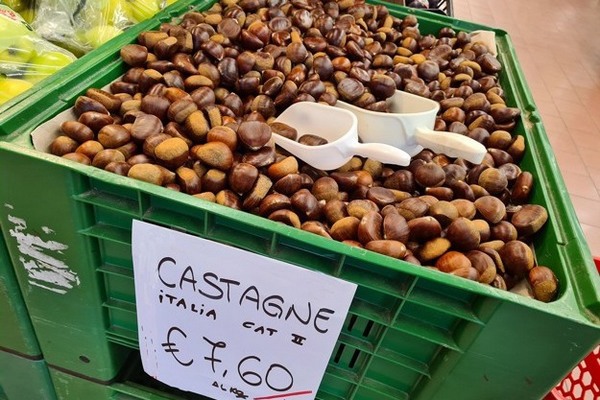In 2023, chestnuts registered a 52% drop in quantities and a 35% drop in value. The data was published by Associazione consorzi castanicoltori Appennino emiliano-romagnolo coordinated by Renzo Panzacchi. "This is due to a series of factors that must be analysed in depth to provide a more detailed reading. Prolonged rain followed abundant blossoming all over the Emilia Romagna Apennines and partly compromised setting."
 Chestnuts sold in a supermarket in October 2023
Chestnuts sold in a supermarket in October 2023
"The heavy rain in May, which caused the disaster that hit the Apennines from East Bologna to Montefeltro, also caused serious structural damage to chestnut groves which could not be salvaged in some cases. Then came a long summer characterized by very high temperatures, always above the seasonal average, which affected the growth and development of the shells. What is more, rain was absent in August, so fruits could not grow."
"Harvesting started around October 10/15 i.e. two weeks later than usual, when daytime temperatures were still around 30°C."
"Commercialization was harder due to problems in complying with the required standards of 70/75 fruits per kg. This is because fruits were much lighter due to the lack of water, meaning 78/80 fruits per kg were necessary. We must also say that, in some areas, the damage caused by Chestnut tortix and Beech moth reached peaks of 40/50%. The damage dropped to 15-20% where sexual disorientation methods were introduced."
The only positive notes were the high sweetness of the fruits due to the high concentration of sugars and the substantial absence of the Gnomoniopsis fungus during harvesting. "As it always happens when produce is scarce, prices remained high. Despite a drop in production of 52%, profits diminished by 35%. A lot of things have happened and the values reported are the result of multiple factors."
The following consortia are part of the Association: Parma Ovest, Reggio, Bologna, Modena, castel del Rio, Vallata Senio, Alta Valle reno, Pieve di Rivoschio.
